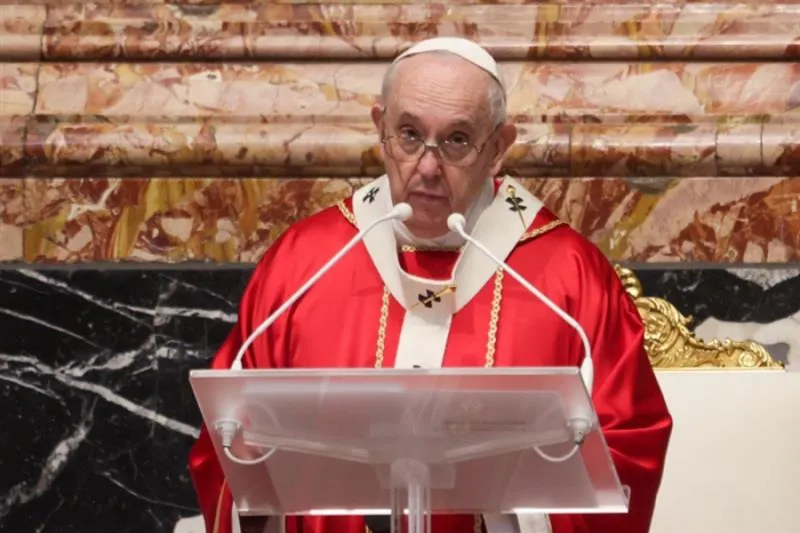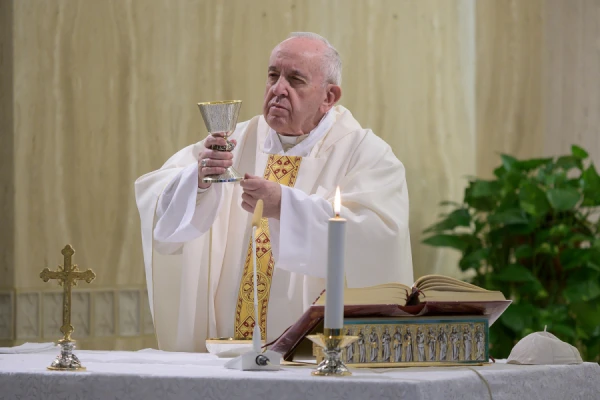
Vatican City, Nov 4, 2021 / 07:00 am (CNA).
Pope Francis celebrated Mass on Thursday for the repose of the souls of 208 cardinals and bishops who died in the past year.
The live-streamed Mass, celebrated at the Altar of the Chair on Nov. 4, was offered for 17 cardinals and 191 bishops and archbishops who died between Nov. 7, 2020, and Oct. 25, 2021.
The elevated number of deaths this year reflects the impact of the coronavirus pandemic on the Catholic Church’s leadership.
Last year’s Mass commemorated six cardinals and 163 bishops who died between October 2019 and October 2020. The year before, the Mass was offered for 13 cardinals and 147 bishops.
In his homily, the pope reflected on the first reading, from Lamentations 3:17-26, in which the author reflects on his sufferings before concluding: “It is good to wait in silence for the Lord to save.”
“This attitude is not a point of departure, but a point of arrival,” he said. “In fact, the author arrives at it at the end of a journey, a bumpy path, which has made him mature. He comes to understand the beauty of trusting the Lord, who never fails to keep his promises.”
“But trust in God is not born of a momentary enthusiasm, it is not an emotion or even just a feeling. On the contrary, it comes from experience and matures in patience, as happened to Job, who passed from a knowledge of God ‘by word of mouth’ to a living, experiential knowledge.”
The pope said that this process required “a long inner transformation” that passed “through the crucible of suffering.”
“Dear brothers and sisters, how important it is to learn the art of waiting for the Lord! Wait for him meekly and confidently, chasing away phantasms, fanaticism, and clamor; guarding, especially in times of trial, a silence full of hope,” he said.
The pope said that this was the way to prepare “for life’s last and greatest test, death.”
But before then, he reflected, Christians must learn to face the trials of the present moment with patience.
“Each of us needs to mature in this,” he commented, noting that difficulties often produce irritation, despondency, pessimism, and resignation.
The pope noted that it was when the author of the Book of Lamentations reached this low point that he encountered God.
“In the abyss, in the anguish of meaninglessness, God approaches to save, in that moment. And when bitterness reaches its peak, hope suddenly flourishes,” he said.
In an off-the-cuff comment, he added: “It’s bad to get to old age with a bitter heart, with a disappointed heart, with a heart critical of new things, it’s very hard.”
The pope said that, while the problems remain, a crisis can offer “a mysterious opportunity for inner purification.”
“He lets us go through narrow passages not to abandon us, but to accompany us. Yes, because God accompanies us, especially in pain, like a father who helps his son grow up well by being close to him in difficulties without taking his place,” he said.
“And before the tears appear on our faces, the emotion has already reddened the eyes of God the Father. He weeps first, let me say. Grief remains a mystery, but in this mystery, we can discover in a new way the paternity of God who visits us in trial, and come to say, with the author of Lamentations: ‘The Lord is good to those who hope in him, to those who seek him.’”
The pope encouraged Christians to ask God for the grace to look at adversity with new eyes.
“Knowing how to wait in silence — without chattering, in silence — for the salvation of the Lord is an art. Let us cultivate it. It is precious in the time in which we are living: now more than ever there is no need to shout, to stir up clamor, to become bitter; what is needed is for each of us to bear witness with our lives to our faith, which is a docile and hopeful expectation.”
“The Christian does not diminish the seriousness of suffering, no, but raises his eyes to the Lord and under the blows of trial he trusts in Him and prays: prays for those who suffer. He keeps his eyes on heaven, but his hands are always extended to earth, to serve his neighbor concretely. Even in the moment of sadness, of darkness, service.”
Among the deceased cardinals and bishops, listed in a booklet accompanying the Mass, were the Brazilians Cardinal José Freire Falcão and Cardinal Eusébio Oscar Scheid, as well as Venezuelan Cardinal Jorge Urosa Savino, who died after testing positive for COVID-19.
Also listed were the Australian Cardinal Edward Idris Cassidy, president of the Pontifical Council for the Promotion of Christian Unity from 1989 to 2001, and the Chilean Cardinal Jorge Arturo Medina Estévez, who announced Benedict XVI’s election in 2005.
Also among the deceased was the Polish Cardinal Henryk Gulbinowicz, who died 10 days after the Vatican imposed sanctions following an investigation into sexual abuse allegations.
Bishops who died in the past year included Bishop Gerald Nicholas Dino, bishop emeritus of the Holy Protection of Mary Byzantine Catholic Eparchy of Phoenix, Arizona; Archbishop Philip Tartaglia of Glasgow; Archbishop Philip Wilson, the archbishop emeritus of Adelaide; Bishop Joseph N. Latino, bishop emeritus of Jackson, Mississippi; Bishop Guy Sansaricq, an auxiliary bishop emeritus of Brooklyn, New York, and the first Haitian-born bishop in the United States; Bishop John B. McCormack, bishop emeritus of Manchester, New Hampshire; Bishop Anthony Pilla, bishop emeritus of Cleveland, Ohio; Bishop Raymundo Peña, bishop emeritus of Brownsville, Texas; and Bishop Manuel Batakian, eparch emeritus of the Armenian Catholic Eparchy of Our Lady of Nareg in the United States and Canada.
Concluding his homily, the pope said: “In this spirit, let us pray for the cardinals and bishops who have left us during the past year. Some of them have died as a result of COVID-19, in difficult situations that compounded their suffering.”
“May these brothers of ours now savor the joy of the Gospel invitation, the one that Lord addresses to his faithful servants: ‘Come, you blessed of my Father, inherit the kingdom prepared for you since the creation of the world’ (Matthew 25:34).”
If you value the news and views Catholic World Report provides, please consider donating to support our efforts. Your contribution will help us continue to make CWR available to all readers worldwide for free, without a subscription. Thank you for your generosity!
Click here for more information on donating to CWR. Click here to sign up for our newsletter.






Leave a Reply